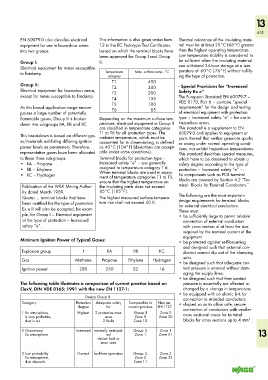Page 617 - Wago_PCB_TerminalBlocksConnectors_Volume2_2015_US
P. 617
13
615
EN 60079-0 also classifies electrical This information is also given under Item Thermal resistance of the insulating mate-
equipment for use in hazardous areas 12 in the EC Prototype Test Certificates, rial must be at least 20°C (68°F) greater
into two groups: based on which the terminal blocks have than the highest operating temperature.
been approved for Group I and Group Low temperature stability is considered to
Group I: II. be sufficient when the insulating material
Electrical equipment for mines susceptible can withstand 24-hour storage at a tem-
perature of -60°C (-76°F) without nullify-
to firedamp. Temperature Max. surface temp. °C
category ing the type of protection.
T1 450
Group II: T2 300 - Special Provisions for “Increased
Electrical equipment for hazardous areas, T3 200 Safety Ex e”
except for mines susceptible to firedamp. T4 135 The European Standard EN 60079-7 –
T5 100 VDE 0170, Part 6 – contains “special
As this broad application range encom- T6 85 requirements” for the design and testing
passes a large number of potentially of electrical equipment with protection
flammable gases, Group II is broken Depending on the maximum surface tem- type – Increased safety “e” – for use in
down into subgroups IIA, IIB and IIC. perature, electrical equipment in Group II hazardous areas.
are classified in temperature categories This standard is a supplement to EN
This breakdown is based on different gas- T1 to T6 for all protection types. The 60079-0 and applies to equipment or
ambient temperature, which must be
parts thereof that neither generate sparks
es/materials exhibiting differing ignition accounted for in dimensioning, is defined or arcing under normal operating condi-
power levels as parameters. Therefore, as 40°C (104°F) (deviations are accept- tions, nor exhibit hazardous temperatures.
representative gases have been allocated able under some conditions). This standard describes special measures,
to these three sub-groups: Terminal blocks for protection type – which have to be observed to obtain a
• IIA – Propane Increased safety “e” – are generally safety degree according to the type of
• IIB – Ethylene assigned to temperature category T 6. protection – Increased safety “e” –.
When terminal blocks are used in equip-
• IIC – Hydrogen ment of temperature categories T1 to T5, Ex components such as PCB terminal
ensure that the highest temperature on blocks are covered by Section 4.2 “Ter-
Publication of the WBK Mining Author- the insulating parts does not exceed minal Blocks for External Conductors.”
ity dated March 1989. 85°C (185°F).
Quote: ... terminal blocks that have The highest measured surface tempera- The following are the most important
been certified for the type of protection ture rise shall not exceed 40 K. design requirements for terminal blocks
for external electrical conductors:
Ex e II will also be accepted, for exam- These must:
ple, for Group I — Electrical equipment • be sufficiently large to permit reliable
of the type of protection — Increased connection of external conductors
safety “e”. with cross section of at least the size
required by the nominal current of the
equipment.
Minimum Ignition Power of Typical Gases: • be protected against self-loosening
and designed such that external con-
Explosion group I IIA IIB IIC ductors cannot slip out of the clamping
Gas Methane Propane Ethylene Hydrogen units.
• be designed such that adequate con-
Ignition power 280 250 82 16 tact pressure is ensured without dam-
aging the supply lines;
• be designed such that their contact
The following table illustrates a comparison of current practice based on pressure is essentially not affected or
ElexV, DIN VDE 0165: 1991 with the new EN 1127-1: changed by a change in temperature;
• be equipped with an elastic link for
Device Group II connection to stranded conductors;
Category Protection Adequate safety Comparable to New per • shaped so as to allow safe, secure
degree for current practice EN 1127
1 Ex atmosphere, Highest 2 protective mea- Group II Zone 0 connection of conductors with smaller
cross sectional areas for terminal
is very probable, sures Zone 0 Zone 20
dust in air 2 faults Zone 10 blocks for cross sections up to 4 mm² .
2 Occasional Increased normally anticipat- Group II, Zone 1 13
Ex atmosphere ed Zone 1 Zone 21
device fault or
error state
3 low probability Normal fault-free operation Group II, Zone 2
Ex atmosphere, Zone 2 Zone 22
dust deposits Zone 11

